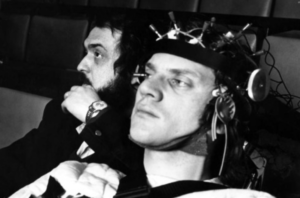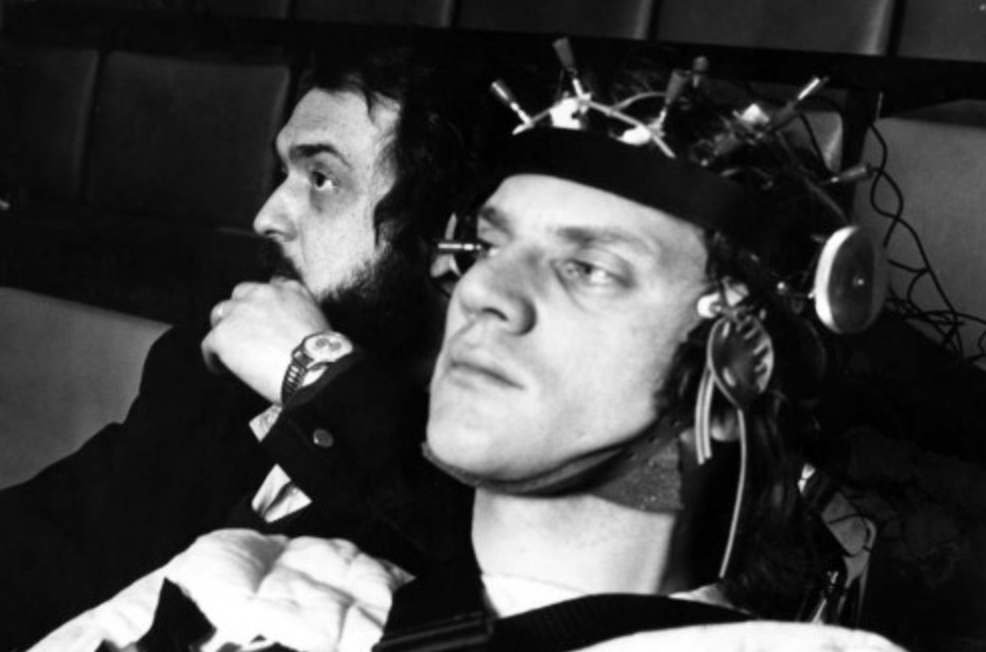
Stanley Kubrick & Malcolm McDowell on the set of “A Clockwork Orange.”
FEATURES | By Bret Bradigan
Kubrick & McDowell
On ‘A Clockwork Orange’s’ 50th Anniversary
(Preview from the Summer OQ, coming end of May) Stanley Kubrick, fresh off the box office disappointment of “2001: A Space Odyssey,” and unable to complete financing for his passion project, “Napoleon,” signed on as director for the film adaptation of the dystopian novel, “A Clockwork Orange.” Expectations weren’t high, though the Anthony Burgess novel had sold well and other film adaptations had been attempted, including one with Mick Jagger as Alex and Keith Richards and the rest of the Stones as the Droogs.
But it was the collaboration between Malcolm McDowell, already a star in his native England for his role as mischievous schoolboy Mick Travis in Lindsay Anderson’s sendup of the British school system, “If,” and Bronx-born Kubrick, which made the film a classic. The timeless study of violence, and its causes and cures, brought out McDowell’s portrayal of gleeful menace and Kubrick’s keen eye for design and human truths — of how fascism, corruption and misplaced idealism lurk beneath the most benign of surfaces.
“I didn’t know how til later how much I collaborated,” McDowell said on the an “Ojai: Talk of the Town podcast.” “I was just the actor.”
Those collaborations include these memorable features:
“I was at Stanley’s house (outside London) 4-5 times a week. We didn’t talk about locations, didn’t talk about character. I said, “What do you think I should wear?” He said, “I don’t know Malcolm.” I asked, “Don’t we have a costumer?” He asked me, “Do you have anything?” “Stanley, what would I have? This is a futuristic movie!” He followed me out to my car, and I showed him my cricket gear. “Put it on, what’s this? What’s this? he said. “A protector.” I told him. “Wear it on the outside,” he said. “And that’s how we came up with one of the most iconic costumes in history of movies.”
“I was looking around this amazing store for a joke gift to give to Stanley. The store mainly was for teenage girls, with futuristic clothes, fun stuff. And I found a yard of eyelash. A yard!” He said, “Malcolm, put it on.” He photographed one eye, then two eyes. He called me the next day, “Wow, look at your face! With one eyelash, you know there’s something wrong but you can’t put your finger on it!’
“We were trying to figure out how to do this sequence, this key scene. The Droogs come to this liberal writer’s house in the country, a terrible invasion. We burst in, then rape or attempt to rape the writer’s wife.
“We had came off shooting the end of movie, the hospital scene, and there was a definite style to it. We were supposed to be throwing bottles through the window, and I said, ‘We can’t just do this, we have got to find a way to elevate this.’ Stanley agreed.
“He literally changed the furniture a couple times. We’d come to work, and there’d be a Harrod’s furniture van. Thee were steps going down, two levels … and I was sitting on the staircase thing. As he passed me he said, “Can you dance?” I said, “Can I dance!” So I started doing the strikes to the beat of ‘Singing in the Rain.’ I mean, Gene Kelly? Who can ever forget?
“Kubrick, as soon as I went into this little routine, shoved me in his car, and we bought the rights to ‘Singing in the Rain’ for $10,000, and spent a week shooting this sequence. It got us over this very difficult thing — this attempted murder-rape. That was not an easy thing. We didn’t even bother throwing bottles through the window.
“Stanley and I had excellent rapport. I love the man. He was amazing, but of course he betrays me at the end, took advantage of a young actor. He wouldn’t talk to my agent about my deal. Had me sign a waiver on my billing for the movie. But who really cares, at the end of the day?
“I knew it was extraordinary, didn’t know how much. We were getting tuff that was outrageous!”
For more insights and observations from one of filmdom’s most impressive actors, check out the “Ojai: Talk of the Town” episode 60 wherever you get your podcasts.


Leave A Comment